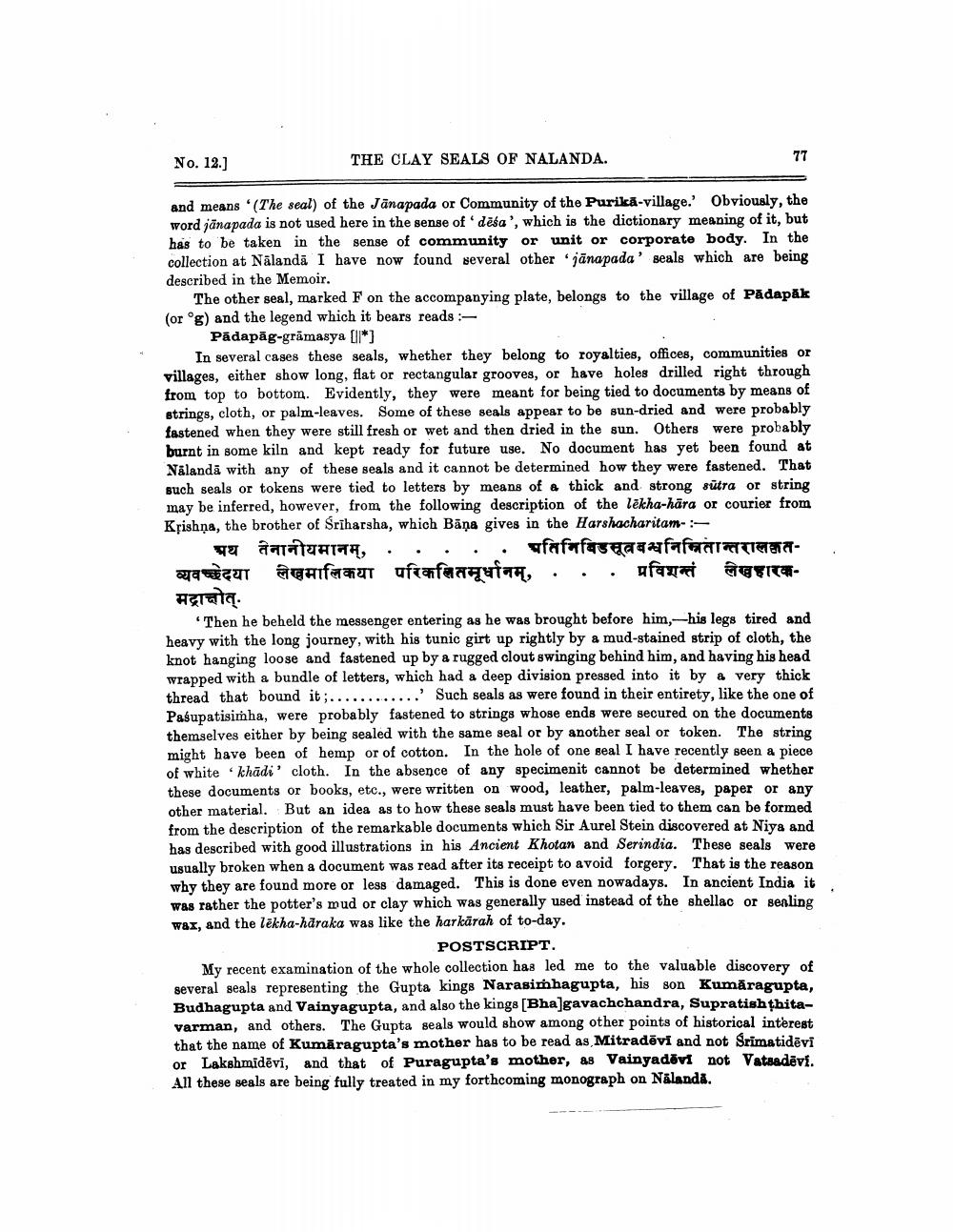________________
THE CLAY SEALS OF NALANDA.
77
No. 12.]
and means (The seal) of the Janapada or Community of the Purika-village.' Obviously, the word janapada is not used here in the sense of 'desa', which is the dictionary meaning of it, but has to be taken in the sense of community or unit or corporate body. In the collection at Nālandā I have now found several other janapada' seals which are being described in the Memoir.
The other seal, marked F on the accompanying plate, belongs to the village of Pädapäk (or g) and the legend which it bears reads:
Pādapag-grāmasya [*]
In several cases these seals, whether they belong to royalties, offices, communities or villages, either show long, flat or rectangular grooves, or have holes drilled right through from top to bottom. Evidently, they were meant for being tied to documents by means of strings, cloth, or palm-leaves. Some of these seals appear to be sun-dried and were probably fastened when they were still fresh or wet and then dried in the sun. Others were probably burnt in some kiln and kept ready for future use. No document has yet been found at Nālandā with any of these seals and it cannot be determined how they were fastened. That such seals or tokens were tied to letters by means of a thick and strong sutra or string may be inferred, however, from the following description of the lekha-hära or courier from Krishna, the brother of Sriharsha, which Bana gives in the Harshacharitam-:
अथ तेनानीयमानम्,
व्यवच्छेदया लेखमालिकया परिकलितमूर्धानम्,
मद्राक्षोत्.
afafafasyarafaforintærerermerप्रविशन्तं लेखहारक
Then he beheld the messenger entering as he was brought before him, his legs tired and heavy with the long journey, with his tunic girt up rightly by a mud-stained strip of cloth, the knot hanging loose and fastened up by a rugged clout swinging behind him, and having his head wrapped with a bundle of letters, which had a deep division pressed into it by a very thick thread that bound it;............' Such seals as were found in their entirety, like the one of Pasupatisimha, were probably fastened to strings whose ends were secured on the documents themselves either by being sealed with the same seal or by another seal or token. The string might have been of hemp or of cotton. In the hole of one seal I have recently seen a piece of white khadi' cloth. In the absence of any specimenit cannot be determined whether these documents or books, etc., were written on wood, leather, palm-leaves, paper or any other material. But an idea as to how these seals must have been tied to them can be formed from the description of the remarkable documents which Sir Aurel Stein discovered at Niya and has described with good illustrations in his Ancient Khotan and Serindia. These seals were usually broken when a document was read after its receipt to avoid forgery. That is the reason why they are found more or less damaged. This is done even nowadays. In ancient India it was rather the potter's mud or clay which was generally used instead of the shellac or sealing wax, and the lekha-haraka was like the harkarah of to-day.
POSTSCRIPT.
My recent examination of the whole collection has led me to the valuable discovery of several seals representing the Gupta kings Narasimhagupta, his son Kumaragupta, Budhagupta and Vainyagupta, and also the kings [Bha]gavachchandra, Supratishthitavarman, and others. The Gupta seals would show among other points of historical interest that the name of Kumaragupta's mother has to be read as Mitradevi and not Srimatidėvi or Lakshmidēvi, and that of Puragupta's mother, as Vainyadevi not Vatsadēvi. All these seals are being fully treated in my forthcoming monograph on Nālandā.




